 HOME
- EXHIBITION
OVERVIEW - OBJECT
LIST
HOME
- EXHIBITION
OVERVIEW - OBJECT
LIST
SECTIONS: I. America as
Refuge - II. 18th Century
America
III. American Revolution - IV. Congress of the
Confederation - V. State
Governments
VI. Federal
Government - VII. New
Republic

III. Religion and the American Revolution
Religion played a
major role in the American Revolution by offering a moral sanction for
opposition to the British--an assurance to the average American that
revolution was justified in the sight of God. As a recent scholar has
observed, "by turning colonial resistance into a righteous cause, and by
crying the message to all ranks in all parts of the colonies, ministers
did the work of secular radicalism and did it better."
Ministers served the American cause in many capacities during the
Revolution: as military chaplains, as penmen for committees of
correspondence, and as members of state legislatures, constitutional
conventions and the national Congress. Some even took up arms, leading
Continental troops in battle.
The Revolution split some denominations, notably the Church of England,
whose ministers were bound by oath to support the King, and the Quakers,
who were traditionally pacifists. Religious practice suffered in certain
places because of the absence of ministers and the destruction of
churches, but in other areas, religion flourished.
The Revolution strengthened millennialist strains in American theology.
At the beginning of the war some ministers were persuaded that, with God's
help, America might become "the principal Seat of the glorious Kingdom
which Christ shall erect upon Earth in the latter Days." Victory over the
British was taken as a sign of God's partiality for America and stimulated
an outpouring of millennialist expectations--the conviction that Christ
would rule on earth for 1,000 years. This attitude combined with a
groundswell of secular optimism about the future of America to create the
buoyant mood of the new nation that became so evident after Jefferson
assumed the presidency in 1801.
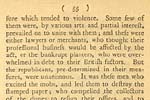 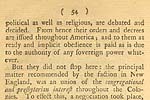 Religion as Cause of the
Revolution Religion as Cause of the
Revolution
Joseph Galloway (1731-1803), a former speaker
of the Pennsylvania Assembly and close friend of Benjamin Franklin,
opposed the Revolution and fled to England in 1778. Like many Tories
he believed, as he asserted in this pamphlet, that the Revolution
was, to a considerable extent, a religious quarrel, caused by
Presbyterians and Congregationalists whose "principles of religion
and polity [were] equally averse to those of the established Church
and Government."
Historical
and Political Reflections on the Rise and Progress
of the
American Rebellion [page 54] - [page
55]
Joseph Galloway, London: G. Wilkie, 1780
Rare Book and Special
Collections Division, Library of Congress (81)
 Jonathan
Mayhew Jonathan
Mayhew
An eloquent proponent of the idea that civil and
religious liberty was ordained by God, Jonathan Mayhew considered
the Church of England as a dangerous, almost diabolical, enemyof the
New England Way. The bishop's mitre with the snake emerging from it
represented his view of the Anglican hierarchy.
Jonathan
Mayhew, D.D. Pastor of the West Church in Boston . .
.
Etching by Giovanni Cipriani, London: 1767
The
American Antiquarian Society, Worcester, Massachusetts (82)
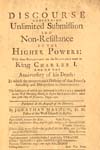 Resistance to Tyranny as
a Christian Duty Resistance to Tyranny as
a Christian Duty
Jonathan Mayhew delivered this
sermon--one of the most influential in American history--on the
anniversary of the execution of Charles I. In it, he explored the
idea that Christians were obliged to suffer under an oppressive
ruler, as some Anglicans argued. Mayhew asserted that resistance to
a tyrant was a "glorious" Christian duty. In offering moral sanction
for political and military resistance, Mayhew anticipated the
position that most ministers took during the conflict with
Britain.
Discourse
Concerning Unlimited Submission and Non-Resistance to the Higher
Powers
Jonathan Mayhew, D.D.
Boston: D. Fowle and
D. Gookin,1750
Rare
Book and Special Collections Division, Library of Congress
(83)
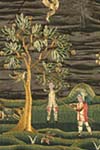 Revolution Understood in
Scriptural Terms Revolution Understood in
Scriptural Terms
Thought to have been created soon after
the Boston Massacre of 1770, this needlework is an excellent example
of how many colonists understood political events in terms of
familiar Bible stories. The creator of the work saw Absalom as a
patriot, rebelling against and suffering from the arbitrary rule of
his father King David (symbolizing George III). The king, shown at
the top left, is playing his harp, evidently oblivious to the
anguish of his children in the American colonies. The figure
executing Absalom--David's commander Joab in the Old Testament
story--is dressed as a British red coat.
The
Hanging of Absalom
Silk, Weft-silk fabric, foil
wrapped threads, paper, watercolor,
attributed to Faith Robinson
Trumbull (1718-1780) c. 1770
Lyman Allyn Art Museum at
Connecticut College, New London, Connecticut (84)
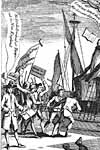 The Plot to Land a
Bishop The Plot to Land a
Bishop
The supposed British plot, to impose Anglican
bishops in the colonies, aroused atavistic fears that Americans
would be persecuted for their religious convictions and further
poisoned relations between Britain and the colonies. In this cartoon
an indignant New England mob pushes a bishop's boat back towards
England, frightening the prelate into praying, "Lord, now lettest
thou thy Servant depart in Peace." The mob flings a volume of
Calvin's Works at the bishop, while brandishing copies of John Locke
and Algernon Sydney on government. The crowd shouts slogans:
"Liberty & Freedom of Conscience"; "No Lords Spiritual or
Temporal in New England"; and "shall they be obliged to maintain
bishops that cannot maintain themselves."
An Attempt
to Land a Bishop in America
Engraving from the
Political Register
London: September, 1769
John Carter
Brown Library at Brown University, Providence, RI (86)
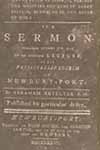 Revolution Justified by
God Revolution Justified by
God
Many Revolutionary War clergy argued that the war
against Britain was approved by God. In this sermon Abraham Keteltas
celebrated the American effort as "the cause of truth, against error
and falsehood . . .the cause of pure and undefiled religion, against
bigotry, superstition, and human invention . . .in short, it is the
cause of heaven against hell--of the kind Parent of the Universe
against the prince of darkness, and the destroyer of the human
race."
God
Arising And Pleading His People's Cause; Or The American War . . .
Shewn To Be The Cause Of God
Abraham
Keteltas
Newbury-Port: John Mycall for Edmund Sawyer, 1777
Rare Book and Special
Collections Division, Library of Congress (87)
 A Minister in
Arms A Minister in
Arms
This satire expresses the British view that the
American Revolution was inspired by the same kind of religious
fanaticism that had fueled Oliver Cromwell's establishment of the
Commonwealth of England more than a century earlier. Among the
ragtag American soldiers is a clergyman holding a flag with a
Liberty Tree on it and claiming " Tis Old Olivers Cause no Monarchy
nor Laws."
The Yankie
Doodles Intrenchments Near Boston 1776
Etching.
Copyprint
British Museum, London, England (88)
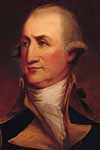 A Fighting
Parson A Fighting
Parson
Peter Muhlenberg (1746-1807) was the prime
example of a "fighting parson" during the Revolutionary War. The
eldest son of the Lutheran patriarch Henry Melchoir Muhlenberg,
young Muhlenberg at the conclusion of a sermon in January 1776 to
his congregation in Woodstock, Virginia, threw off his clerical
robes to reveal the uniform of a Virginia militia officer. Having
served with distinction throughout the war, Muhlenberg commanded a
brigade that successfully stormed the British lines at Yorktown. He
retired from the army in 1783 as a brevetted major general.
John Peter
Gabriel Muhlenberg
Oil on canvas, by an unidentified
American artist
Nineteenth century
Martin Art Gallery,
Muhlenberg College, Allentown, Pennsylvania (89)
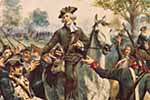 A Revolutionary
Chaplain A Revolutionary
Chaplain
James Caldwell (1734-1781), a Presbyterian
minister at Elizabeth, New Jersey, was one of the many clergymen who
served as chaplains during the Revolutionary War. At the battle of
Springfield, New Jersey, on June 23, 1780, when his company ran out
of wadding, Caldwell was said to have dashed into a nearby
Presbyterian Church, scooped up as many Watts hymnals as he could
carry, and distributed them to the troops, shouting "put Watts into
them, boys." Caldwell and his wife were both killed before the war
ended.
Reverend
James Caldwell at the Battle of Springfield
Watercolor by Henry Alexander Ogden
Presbyterian
Historical Society, Philadelphia (90)
 Revolutionary Battle
Flag Revolutionary Battle
Flag
Like this one, many battle flags of the American
Revolution carried religious inscriptions.
Gostelowe
Standard No. 10, c. 1776
Watercolor once in possession
of Edward W. Richardson. Copyprint
Courtesy of the Pennsylvania
Society of Sons of the Revolution
and Its Color Guard (91)
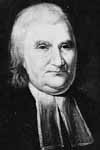 John
Witherspoon John
Witherspoon
John Witherspoon (1723-1794) was the most
important "political parson" of the Revolutionary period. He
represented New Jersey in the Continental Congress from 1776 to
1782, in which capacity he signed the Declaration of Independence
and served on more than one hundred committees. As president of
Princeton, Witherspoon was accused of turning the institution into a
"seminary of sedition."
John
Witherspoon
Oil on canvas, by Rembrandt Peale after
Charles Wilson Peale, 1794
National Portrait Gallery, Washington,
D.C. (92)
 A Quaker
Schism A Quaker
Schism
Some Quakers were conscientiously convinced that
they could, despite the Friends' peace testimony, take up arms
against the British. Calling themselves "Free Quakers," they
organized in Philadelphia. The majority of Quakers adhered to the
denomination's traditional position of pacifism and disowned their
belligerent brethren. This Free Quaker broadside declares that
although the "regular" Quakers have "separated yourselves from us,
and declared that you have no unity with us," the schism does not
compromise the Free Quakers' rights to common property.
To those
of our Brethren who have disowned us.
Broadside, July
9, 1781
Manuscript
Division, Library of Congress (93)
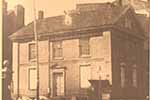 Free Quaker Meeting
House Free Quaker Meeting
House
The Free Quakers built their own Meeting House in
Philadelphia.
Free
Quaker Meeting House,
SW corner 5th and Arch St.,
Philadelphia, Pa.
Photograph
Manuscript Division, Library
of Congress (94)
|

THE PROBLEMS OF THE AMERICAN ANGLICANS
| The American Revolution inflicted deeper
wounds on the Church of England in America than on any other
denomination because the King of England was the head of the church.
Anglican priests, at their ordination, swore allegiance to the King.
The Book of Common Prayer offered prayers for the monarch,
beseeching God "to be his defender and keeper, giving him victory
over all his enemies," who in 1776 were American soldiers as well as
friends and neighbors of American Anglicans. Loyalty to the church
and to its head could be construed as treason to the American cause.
Patriotic American Anglicans, loathe to discard so fundamental a
component of their faith as The Book of Common Prayer,
revised it to conform to the political realities.
|
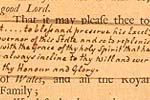 Maryland's Revised Book
of Common Prayer Maryland's Revised Book
of Common Prayer
The Maryland Convention voted on May
25, 1776, "that every Prayer and Petition for the King's Majesty, in
the book of Common Prayer . . . be henceforth omitted in all
Churches and Chapels in this Province." The rector of Christ Church
(then called Chaptico Church) in St. Mary's County, Maryland, placed
over the offending passages strips of paper showing prayers composed
for the Continental Congress. The petition that God "keep and
strengthen in the true worshipping of thee, in righteousness and
holiness of life, thy servant GEORGE, our most gracious King and
Governour" was changed to a plea that "it might please thee to bless
the honorable Congress with Wisdom to discern and Integrity to
pursue the true Interest of the United States."
Book of
Common Prayer
England: John Baskerville, c.
1762
Washington National Cathedral Rare Books Library (95)
|
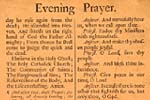 Christ Church,
Philadelphia's Revised Book of Common Prayer Christ Church,
Philadelphia's Revised Book of Common Prayer
The problem
was handled differently by Christ Church, Philadelphia. The rector,
the Reverend Jacob Duch, called a special vestry meeting on July 4,
1776, to ask whether it was advisable "for the peace and welfare of
the congregation, to shut up the churches or to continue the
service, without using the prayers for the Royal Family." The vestry
decided to keep the church open but replace the prayers for the King
with a prayer for Congress: "That is may please thee to endue the
Congress of the United States & all others in Authority,
legislative, executive, & judicial with grace, wisdom &
understanding, to execute Justice and to maintain Truth."
Book of
Common Prayer
London: Mark Basket, 1766
Courtesy of
the Rector, Church Wardens, and Vestrymen of Christ Church,
Philadelphia (96)
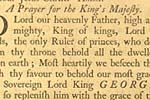 
Book of
Common Prayer [left page] - [right
page]
Here is a facsimile of the page from the Book of
Common Prayer,
containing the prayers for the king, that were
altered in various ways.
Oxford: Printed by Mark Basket, printer
to the University, 1763
Copyprint
Rare Book and Special
Collections Division, Library of Congress (95a)
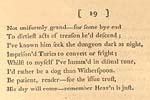 A Tory Preacher on the
Attack A Tory Preacher on the
Attack
More than half of the Anglican priests in
America, unable to reconcile their oaths of allegiance to George III
with the independence of the United States, relinquished their
pulpits during the Revolutionary War. Some of the more intrepid
priests put their loyalty to the Crown at the service of British
forces in America. One of these, Jonathan Odell (1737-1818), rector
at Burlington, New Jersey, became a confidant of Benedict Arnold and
scourged the Patriots with a sharp, satirical pen. This long, rhymed
attack on John Witherspoon contains the clumsy couplet, "Whilst to
myself I've humm'd in dismal tune, I'd rather be a dog than
Witherspoon." Odell blasted his fellow Anglican ministers, who
supported the American cause, for apostasy.
The
American Times: A Satire in Three Parts in which are delineated . .
. the Leaders of the American Rebellion
Jonathan Odell,
London: 1780
Rare
Book and Special Collections Division, Library of Congress
(97)
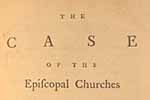 An Argument for an
American Episcopal Church An Argument for an
American Episcopal Church
In the years following
American independence, Anglican ministers who had remained in the
colonies began planning for an independent American church. One of
the publications that focused discussion on the issue was this
volume by William White. A series of conferences in the 1780s failed
to bridge the differences between two parties that emerged but, at a
convention in 1789, the two groups formed the Protestant Episcopal
Church of the United States. A church government and revised Book of
Common Prayer believed to be compatible with a rising democratic
nation were adopted.
The Case
of the Episcopal Churches in the United States Considered
William White
Philadelphia: David Claypoole,
1782
Rare Book and
Special Collections Division, Library of Congress (98)
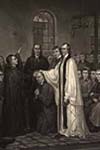 The Establishment of the
Methodist Episcopal Church The Establishment of the
Methodist Episcopal Church
The independence of the
United States stimulated American Methodists, as it did their
brethren in the Church of England, with whom the Methodists had
considered themselves "in communion," to organize themselves as an
independent, American church. This happened at the Christmas
Conference in Baltimore in 1784, where Francis Asbury and Thomas
Coke were elected as superintendents of the new Methodist Episcopal
Church. Asbury was ordained as deacon, elder, and superintendent.
American Methodists adopted the title of bishop for their leaders
three years later.
The
Ordination of Bishop Asbury, and the Organization of the Methodist
Episcopal Church.
Engraving by A. Gilchrist Campbell,
1882, after a painting by Thomas Coke Ruckle
Prints and Photographs
Division, Library of Congress.
Gift of the Lovely Lane
Museum, Baltimore (99)
![Acts and Proceedings of the Synod of New-York and Philadelphia, A.D.1787, & 1788 [right]](images/vc6770th.jpg) ![Acts and Proceedings of the Synod of New-York and Philadelphia, A.D.1787, & 1788 [left]](images/vc6769th.jpg) Reforms in the
Presbyterian Church Reforms in the
Presbyterian Church
Like the Anglicans and Methodists,
Presbyterians reorganized their church as a distinctly American
entity, thereby reducing some of the influence of the Church of
Scotland. From debates at the synods of 1787 and 1788 emerged a new
Plan of Government and Discipline, a Directory of Public Worship,
and a revised version of the Westminster Confession, which was made
"a part of the constitution." In the proceedings of the 1787 and
1788 synods, shown here, the Presbyterian Church, along with other
contemporary American churches, took a stand against slavery,
recommending that Presbyterians work to "procure, eventually, the
final abolition of slavery in America."
Acts and
Proceedings of the Synod of New-York
and Philadelphia, A.D.1787,
& 1788 [left page] - [right
page]
Philadelphia: Francis Bailey, 1788
Rare Book and Special
Collections Division, Library of Congress (100)
|
 HOME
- EXHIBITION
OVERVIEW - OBJECT
LIST
HOME
- EXHIBITION
OVERVIEW - OBJECT
LIST
SECTIONS: I. America as
Refuge - II. 18th Century
America
III. American Revolution - IV. Congress of the
Confederation - V. State
Governments
VI. Federal
Government - VII. New
Republic

Go to:
 Library of Congress Library of Congress
Comments: Contact Us
(06/03/98)
|
 HOME
- EXHIBITION
OVERVIEW - OBJECT
LIST
HOME
- EXHIBITION
OVERVIEW - OBJECT
LIST




















![Acts and Proceedings of the Synod of New-York and Philadelphia, A.D.1787, & 1788 [right]](images/vc6770th.jpg)
![Acts and Proceedings of the Synod of New-York and Philadelphia, A.D.1787, & 1788 [left]](images/vc6769th.jpg)